Remember when cloud computing became a major tech leap for enterprises? It revolutionized IT infrastructure management, enabling scalable and flexible resource allocation, reducing costs, and providing global accessibility.
Now, generative AI promises a greater technological leap for enterprises. This subset of AI can create new content, ideas, or solutions within business environments. It is transforming even knowledge-intensive tasks like enterprise search, taking them from basic automation to more sophisticated, context-aware, and proactive systems.
The impact of AI in business, however, goes far beyond these generative capabilities. From predictive analytics to autonomous decision-making, AI is reshaping how enterprises operate across all sectors. In this blog, we’ll explore innovative use cases of AI in enterprise across various industries with real-world examples.
Key applications of AI in enterprise
The applications of enterprise AI are vast and far-reaching, spanning multiple domains and functions. Here are some key use cases that illustrate AI’s transformative potential for enterprises.
A. Streamlining operations
The specific applications of AI in streamlining operations and process automation may vary across sectors, but the underlying goal remains the same—enhancing efficiency, agility, and cost reduction. Here’s how different kinds of enterprises can apply AI to streamline operations.
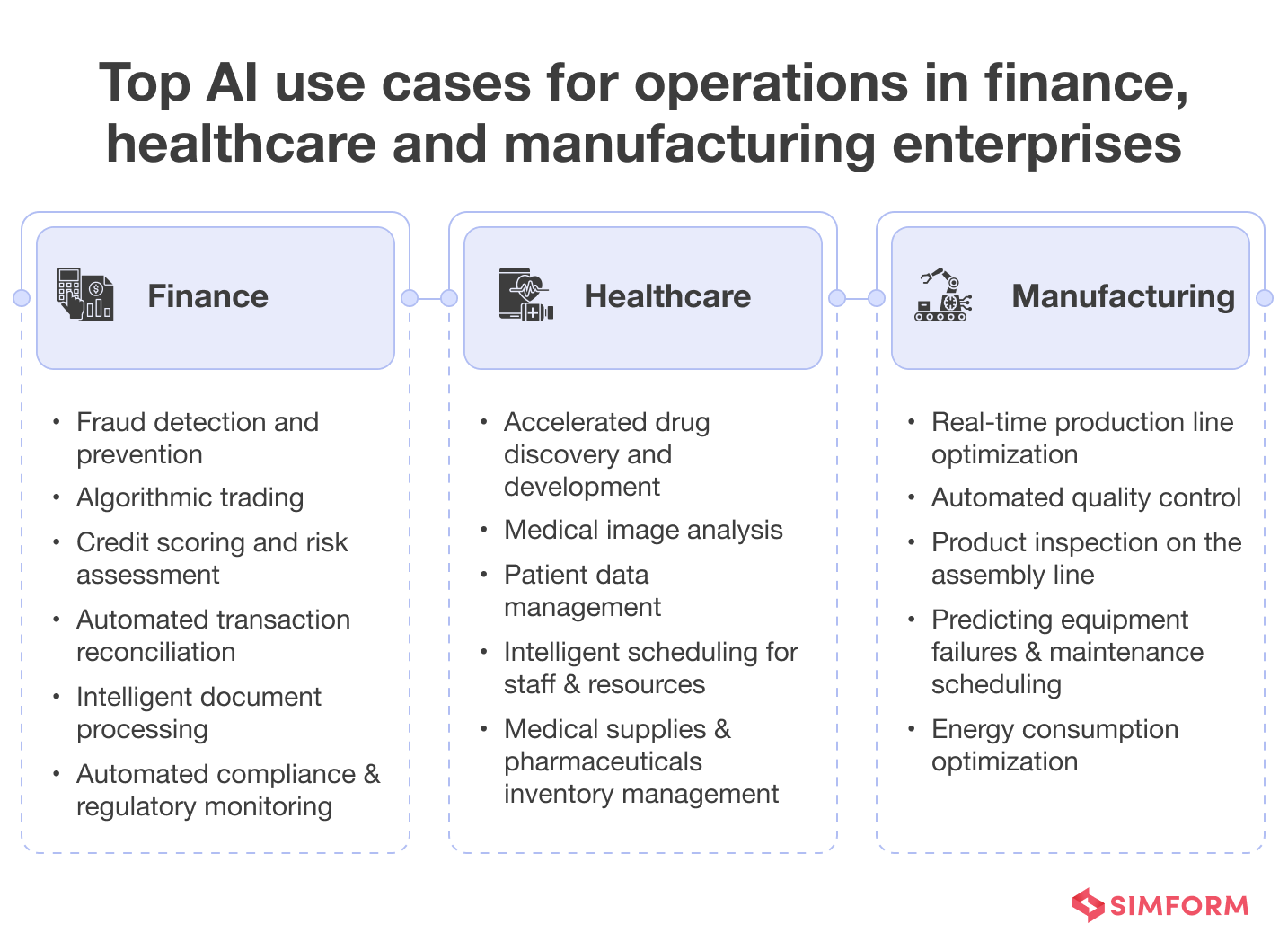
However, certain AI-driven operational use cases are more common across the sectors than others. We have discussed them in detail below.
1. Intelligent Process Automation (IPA)
IPA combines robotic process automation (RPA) with advanced AI capabilities. These features can automate complex, multi-step processes involving decision-making, exception handling, and unstructured data processing:
- Natural language processing (NLP) techniques like named entity recognition, relation extraction, and text classification are used to understand and interpret unstructured data (e.g., documents, emails, forms).
- Computer vision algorithms are employed for optical character recognition (OCR) and image understanding.
- Machine learning (ML) models, such as decision trees, random forests, and neural networks, can be trained on historical process data. This training allows these models to learn decision logic, handle exceptions, and adapt to process variations.
IPA can automate document verification and application processing in finance enterprises, insurance claim processing and patient record management in health, visual inspections and quality control in manufacturing, and so on.
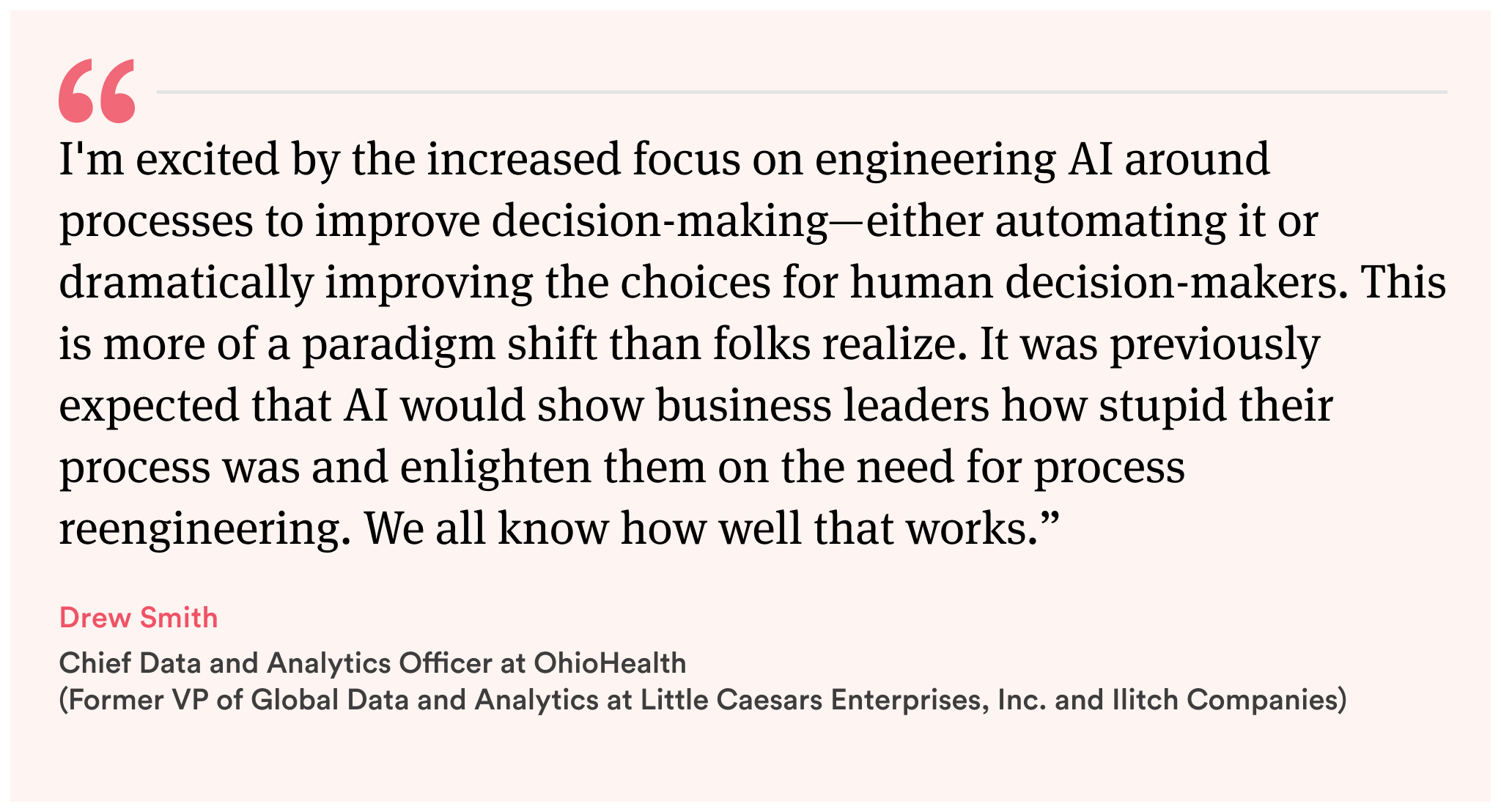
2. Anomaly detection
Anomaly detection is a crucial AI application for enterprises to identify unusual patterns or deviations from expected behavior in data.
Machine learning models, such as autoencoders or one-class support vector machines (SVMs), are trained on relevant data to learn the patterns representing normal behavior. They analyze new data and assign an anomaly score or probability to each data point, indicating the degree of deviation from the learned normal patterns.
Data points with anomaly scores exceeding a predetermined threshold are flagged as potential anomalies, triggering alerts or further investigation. AI can help companies detect anomalies in many areas:
| Industry | Anomaly detection applications with AI |
| Manufacturing | Catching defects, quality issues, or equipment malfunctions for timely corrective actions and minimizing waste |
| Healthcare | Identifying unusual patterns in patient vital signs, medical imaging, or EHR, potentially leading to the early detection of diseases or medical conditions |
| Telecommunications | Spotting network issues, unusual traffic patterns, or potential service disruptions for proactive maintenance and ensuring service quality |
| Energy | Monitoring power grid operations, identifying potential equipment failures or abnormal energy consumption patterns, thus improving grid reliability and efficiency |
| Finance | Detecting anomalies in financial transactions to identify potential fraud, money laundering, or unauthorized trading activities |
At BMW, for example, 26 cameras are used throughout the factory floor to snap photos. AI then identifies issues and flags them for workers to fix, thus preventing the shipping out of an imperfect vehicle. GE leverages AI to analyze data directly from aircraft engines to identify problems and required maintenance, and ensure the overall safety of aircraft.
3. Supply chain optimization
For industries with complex supply chains, such as retail, e-commerce, logistics, etc., AI-driven solutions streamline their supply chain operations, minimize waste, and ensure timely delivery of products and services.
- Demand forecasting: ML models analyze historical sales data, customer behavior patterns, market trends, and external factors (e.g., weather, economic conditions) to accurately forecast future demand for products or services.
- Inventory optimization: Based on demand forecasts and other factors, AI algorithms optimize inventory levels across the supply chain to ensure availability while minimizing overstocking or understocking.
- Route planning: AI analyzes various routes, considering factors like traffic patterns, weather conditions, and delivery constraints, to plan the most efficient delivery routes.
- Supplier risk assessment: AI models can also evaluate supplier risks by analyzing financial stability, quality control measures, past performance, and external data sources.
Retail giant Nordstrom uses AI to manage and control inventory, navigate order fulfillment, and route orders to the nearest store for its customers. Other major players, including Walmart, Amazon, and UPS, also use AI for various aspects of their operations to meet customer demands more effectively.
4. Predictive maintenance
In asset-intensive enterprises like oil and gas, manufacturing, utilities, transportation, etc., AI is employed for predictive maintenance. It enables companies to monitor equipment health, predict potential failures, and schedule maintenance activities proactively. This approach minimizes unplanned downtime, extends asset lifespan, and optimizes maintenance operations.
Sensor data from equipment, maintenance logs, and operational parameters are collected and preprocessed. ML algorithms, particularly time-series forecasting models like long short-term memory (LSTM) networks and regression techniques, are trained on this data to learn patterns and identify anomalies that may indicate potential failures or maintenance requirements.
| Simform developed a predictive fleet maintenance solution for Tryg
Tryg-i-bil is one of the largest general insurance companies in Scandinavia. They wanted to build an advanced solution that makes auto insurance settlement claims more efficient and straightforward. However, analyzing the data from fleet sensors was the primary challenge. We built an end-to-end vehicle tracking and fleet management solution for their fleet operators and drivers. We used Azure Stream Analytics, which has built-in ML capabilities, to clean vehicle telemetry data in real time. That data is leveraged to derive real-time and predictive insights, such as emerging vehicle health issues and other downstream processes like vehicle surveys post-accident, insurance claims, etc. |
How Tryg reduced operational costs by 50% with our solution
B. Finance and accounting
5. Financial forecasting and budgeting
AI uses historical financial data, market trends, and economic indicators to generate accurate forecasts and optimize budgeting processes.
Time-series forecasting techniques are employed to forecast financial metrics like revenue, expenses, and cash flow based on historical data. ML algorithms like recurrent neural networks (RNNs) can capture complex temporal patterns and dependencies in financial data, improving forecast accuracy. Additionally, external factors like market trends, economic indicators, and competitive landscape can be incorporated through feature engineering or transfer learning.
Financial modeling
AI can also be applied to financial modeling to create more accurate quantitative representations of a company’s operations and financial performance. It can simulate and stress-test financial models under different scenarios and provide insights into potential risks and opportunities.
6. Automated report generation
Using NLP, computer vision, and generative AI models can automate the process of generating various types of reports (financial, sales, and analytics reports). This reduces manual effort, increases efficiency, and minimizes errors.
Language models (e.g., GPT-3.5) and structured data generators generate report content based on the processed data and predefined templates or prompts. These models can come up with natural language narratives, summaries, and insights, as well as populate data fields and generate visualizations.
Quality assurance: AI/ML algorithms can also analyze and validate the generated reports, flagging potential errors or inconsistencies based on predefined rules or historical patterns.
Companies like Automated Insights offer AI-powered automated reporting solutions used across various industries, including finance, marketing, and business intelligence.
C. Marketing and sales
7. Customer segmentation and targeting
Customer segmentation based on demographics, behavior, preferences, and purchasing patterns enables targeted marketing efforts and personalized campaigns. AI has broadened this scope with advanced targeting and segmentation.
Clustering algorithms like k-means, hierarchical clustering, and density-based clustering (DBSCAN) group customers into segments based on various attributes. These algorithms can identify natural clusters or groups within the customer data. Further, ML algorithms like decision trees, random forests, and neural networks can also be trained to predict segment membership for new customers based on their attributes.
Thus, you can send targeted ads that are more likely to lead to sales without wasting resources on ads that don’t resonate with your target audience.
A prominent example is Starbucks’ AI-driven Deep Brew program, which offers personalized marketing at scale. By analyzing customer data, the program lets Starbucks tailor its outreach and offer individualized promotions and recommendations.
8. Personalized recommendations and content
For superior conversion rates, personalize recommendations and marketing messages through AI.
Collaborative filtering techniques, such as neighborhood-based methods (which evaluate a user’s preference for an item based on ratings of neighboring items by the same user), personalize recommendations based on user preferences and behavior. Content-based filtering algorithms can also be employed to recommend items based on a user’s past interests.
For content optimization, techniques like reinforcement learning can test different content variations (e.g., headlines, images, CTAs) and optimize for metrics like engagement, click-through rates, and conversions.
For instance, developers revealed an innovative application, JoeCRM, at a hackathon hosted by Meta. They used Meta’s Llama 3, an open-source large language model (LLM), to build an AI-first CRM that automates customer research and drafts outreach campaigns.
1/ JoeCRM
AI-first CRM that receives signals about customers, performs research about them, and automatically drafts outreach campaigns@GregTanaka pic.twitter.com/CdsbRX9AC3
— Alex Reibman 🖇️ (@AlexReibman) May 13, 2024
9. Sales forecasting and lead scoring
AI can further forecast sales performance and prioritize leads based on their likelihood of conversion, thus optimizing sales strategies and resource allocation.
Time-series forecasting techniques like ARIMA, exponential smoothing, and Prophet (by Facebook) predict future sales based on historical data.
Machine learning algorithms like gradient boosting are employed for lead scoring by training on historical lead data and conversion outcomes. These models identify patterns and features that distinguish high-value leads from low-value ones. Additionally, predictive modeling techniques like uplift modeling can be used to estimate the incremental impact of marketing activities on sales and lead conversions.
D. Customer service and support
10. AI-powered chatbots and virtual assistants
Generative AI models like GPT (Generative Pre-trained Transformer) have revolutionized the development of conversational AI systems. These models are trained on vast amounts of text data, allowing them to understand and generate human-like responses to a wide range of queries. They can also adapt to the specific needs of different industries, from retail to healthcare, thereby improving customer experience and satisfaction.
Intelligent virtual assistants (IVAs) and chatbots powered by this conversational AI technology can provide 24/7 customer support, resolve issues efficiently, automate tasks, and much more.
For instance, Walmart is innovatively integrating AI for this use case across its business. With a simple text chat, customers can search for items, add or remove products from their cart, reorder, and schedule a delivery or pickup.
Walmart has also introduced a conversational AI called Ask Sam for in-store associates. This AI helper assists them with all sorts of queries, such as finding a specific product in the store or looking up prices—all with simple questions.
11. Sentiment analysis of feedback
Sentiment analysis, or opinion mining, leverages NLP and machine learning to identify and extract subjective information from text data. By analyzing customer feedback, reviews, social media interactions, and other sources, businesses can gain valuable insights into customer sentiment, preferences, and pain points.
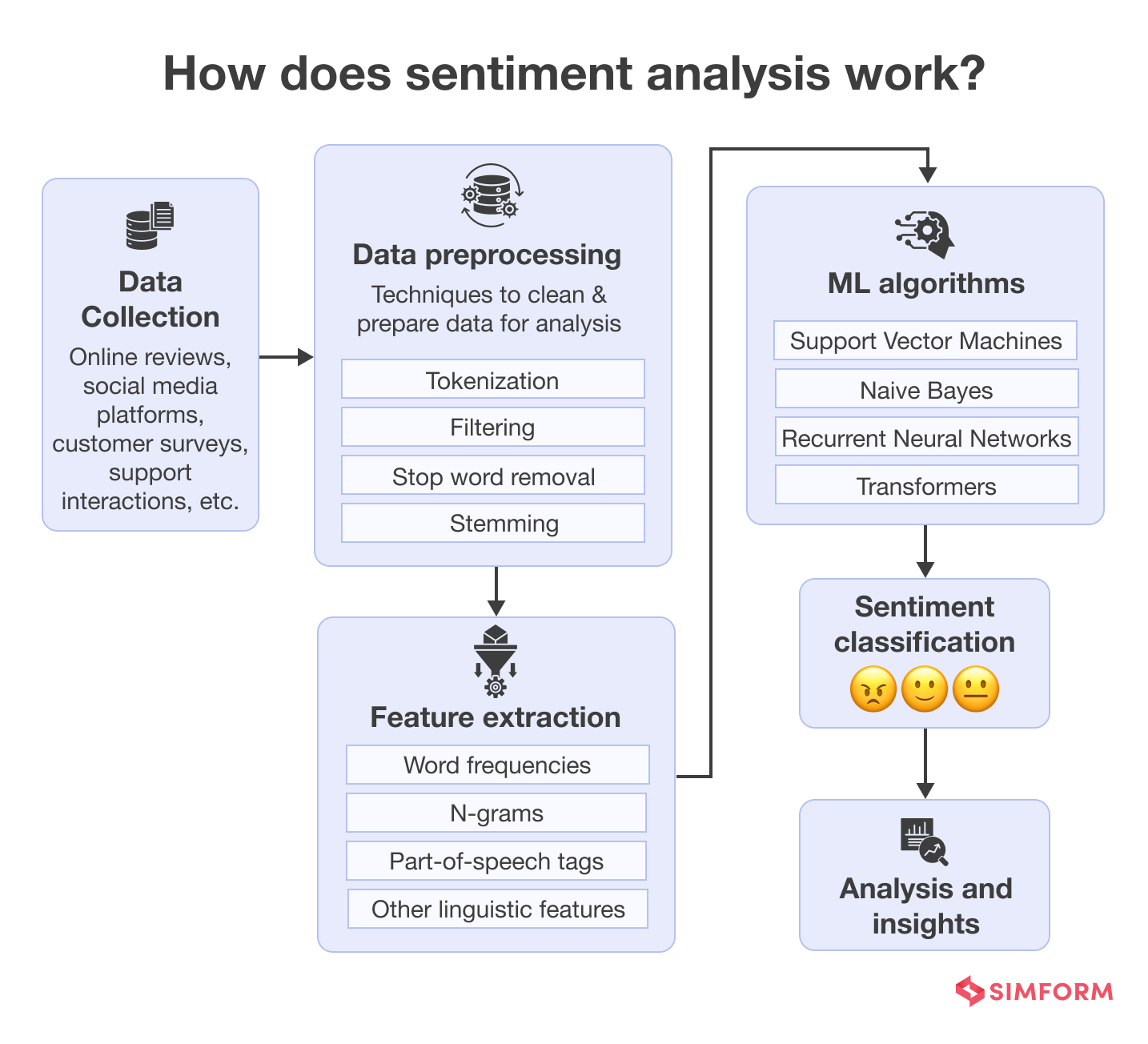
Amazon has a Fit Insights Tool that uses LLMs to extract and aggregate customer feedback on fit, style, and fabric for apparel on Amazon. It contextualizes product returns and size chart analyses with customer reviews, using ML to identify defects in size charts. Brands can leverage this data to better understand customer fit issues, improve how they communicate sizing to customers, and even incorporate feedback into future designs and manufacturing.
12. Predictive analytics for churn prediction
AI models can also be trained to predict the likelihood of churn among current customers. This data can then be used to develop targeted retention strategies, such as personalized offers, loyalty programs, or proactive customer support, to reduce churn and improve customer loyalty.
E. Human resources
13. Candidate screening and resume analysis
AI techniques like NLP and machine learning techniques extract relevant information from resumes and job descriptions, allowing for more efficient candidate evaluation and matching.
- Automated screening: AI models can automatically screen resumes based on predefined criteria, reducing the time and effort required by human recruiters.
- Resume parsing: NLP algorithms extract key information from resumes, such as work experience, educational qualifications, skills, and achievements.
- Skill matching: ML models are trained to analyze the data and match candidate skills and experience with job requirements, identifying the most suitable candidates.
- Predictive modeling: AI can also analyze historical data on successful hires to identify patterns and predict the likelihood of success for new candidates, aiding in the selection process.
For example, Unilever deployed video analyzing software to screen job candidates. In the second round of interviews, candidates answer questions for 30 minutes, during which the software analyzes their facial expressions, body language, and word choices using NLP and body language analysis.

How we built a highly bespoke recruitment platform for hospitality domain
14. Employee training and skill development
AI-driven approaches help employees acquire relevant skills more efficiently and effectively. It could enable them to achieve career goals while ensuring that training meets organizational objectives.
AI models analyze employee performance data, training records, and other relevant information to assess their current skill levels and identify areas for improvement. Based on individual skill gaps and learning preferences, AI can create personalized learning paths and recommend relevant training materials, courses, or resources.
Additionally, AI-powered adaptive learning systems can adjust the pace, difficulty, and training content based on the learner’s progress and comprehension.
Onboarding and training
AI-powered chatbots can also ease employee onboarding by answering questions, providing personalized onboarding materials, and guiding them through training modules.
Zavvy’s AI-powered coach evaluates employee performance, offers tailored recommendations, and crafts personalized growth plans. It also provides answers and support to learners based on your course content, saving the time usually spent on these tasks. Additionally, it can translate content into multiple languages, supporting a global workforce.
15. Workforce planning and optimization
AI in workforce planning was initially used for simple, repetitive tasks like scheduling. Now, it has become a powerful tool that offers sophisticated predictive and prescriptive analytics to drive strategic HR decisions.
AI models can continuously monitor and analyze data to predict departmental staffing shortages, track turnover rates, and identify emerging skills necessary for future projects. By generating optimal workforce allocation plans, it helps ensure the right talent and resources are available at the right time.
AI can also give a deeper understanding of labor costs and effectiveness, helping drive well-informed decisions about resource allocation and budget management.
For example, AI tools in healthcare can predict patient inflows and help manage staffing levels, ensuring hospitals are adequately staffed during peak times without overstaffing during slower periods. This predictive capability allows hospitals to maintain optimal staff-to-patient ratios, enhancing patient care and staff satisfaction while controlling costs. Similarly, for retailers, AI can align staffing with expected customer traffic, particularly during peak shopping seasons.
Companies such as Walmart, Target, Starbucks, Delta Airlines, Costco and more use AI to identify the best schedule for their needs.
F. IT and security
16. Cybersecurity and threat detection
Traditional security measures struggle to keep up with the ever-increasing volume and complexity of cyber threats. Advanced AI-powered solutions enhance cybersecurity and detection of potential threats while reducing breaches caused by human errors.
For instance, you can deploy self-learning AI models that analyze network traffic, log files, user behavior, and other data to establish a baseline of normal activity. This enables the model to identify deviations that may indicate potential threats and respond in real time. AI systems can also be trained to detect insider threats or compromised accounts.
Unsupervised machine learning techniques like clustering and anomaly detection algorithms (e.g., isolation forests, one-class SVMs) identify unusual patterns or deviations from normal behavior. Whereas, supervised learning algorithms trained on labeled data classify and detect specific types of threats (e.g., known attack patterns).
In these ways and more, organizations can create a more robust and adaptive cybersecurity posture by leveraging different AI-powered techniques.
17. Code generation
From writing entire applications based on natural language descriptions or specifications to allowing developers to advance complex coding more efficiently, AI has made significant advancements in code generation. Software developers are now using enterprise generative AI tools for various coding tasks.
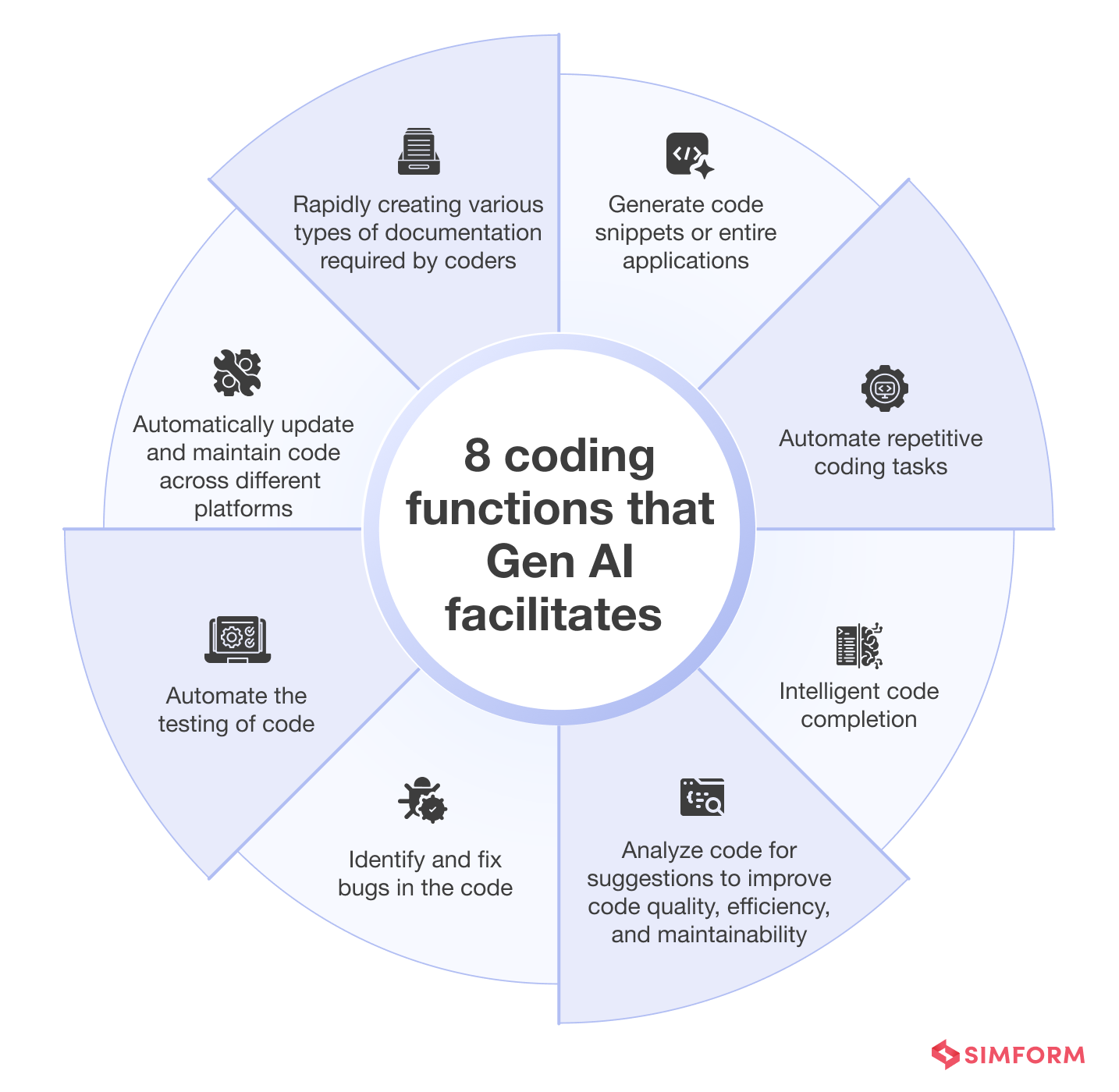
AI models also analyze data structures, schemas, or APIs and generate code to interact with or manipulate that data, automating various data-related coding tasks.
Unilever, the consumer packaged goods (CPG) titan, is leveraging GPT API to develop AI tools to auto-generate product listings and minimize food waste. It is also using the API to build a platform that filters emails sent to customer service, sorts spam from legitimate messages, and scales those up to customer service agents.
By leveraging AI-powered code generation capabilities, enterprises gain a competitive advantage with streamlined development processes, maintenance, improved developer productivity, and faster time-to-market for new and innovative features/products.
18. Predictive maintenance of IT assets
For enteprises that have digital services working round-the-clock, maintaining uptime and reliability is a top priority. AI can be leveraged to monitor and predict the maintenance needs of IT assets, such as servers, networks, and storage systems, enabling proactive maintenance and minimizing downtime.
Various data (system logs, sensor data, performance metrics, etc.) from IT assets are collected and preprocessed. ML algorithms, particularly time-series forecasting models like long short-term memory (LSTM) networks and regression techniques, are trained on this data to learn patterns and identify anomalies that may indicate potential failures or maintenance requirements.
Overall, AI models help monitor IT assets in real time and predict when maintenance activities, such as software updates, hardware replacements, or configuration changes, may be required.
IT service desk automation
AI can also automate basic IT service desk tasks (like password resets and troubleshooting common issues), freeing up IT staff to focus on more complex problems and easing overall IT operations management.
IT is the most preferred area for gen AI-innovation, according to our Generative AI Executive Survey 2024.
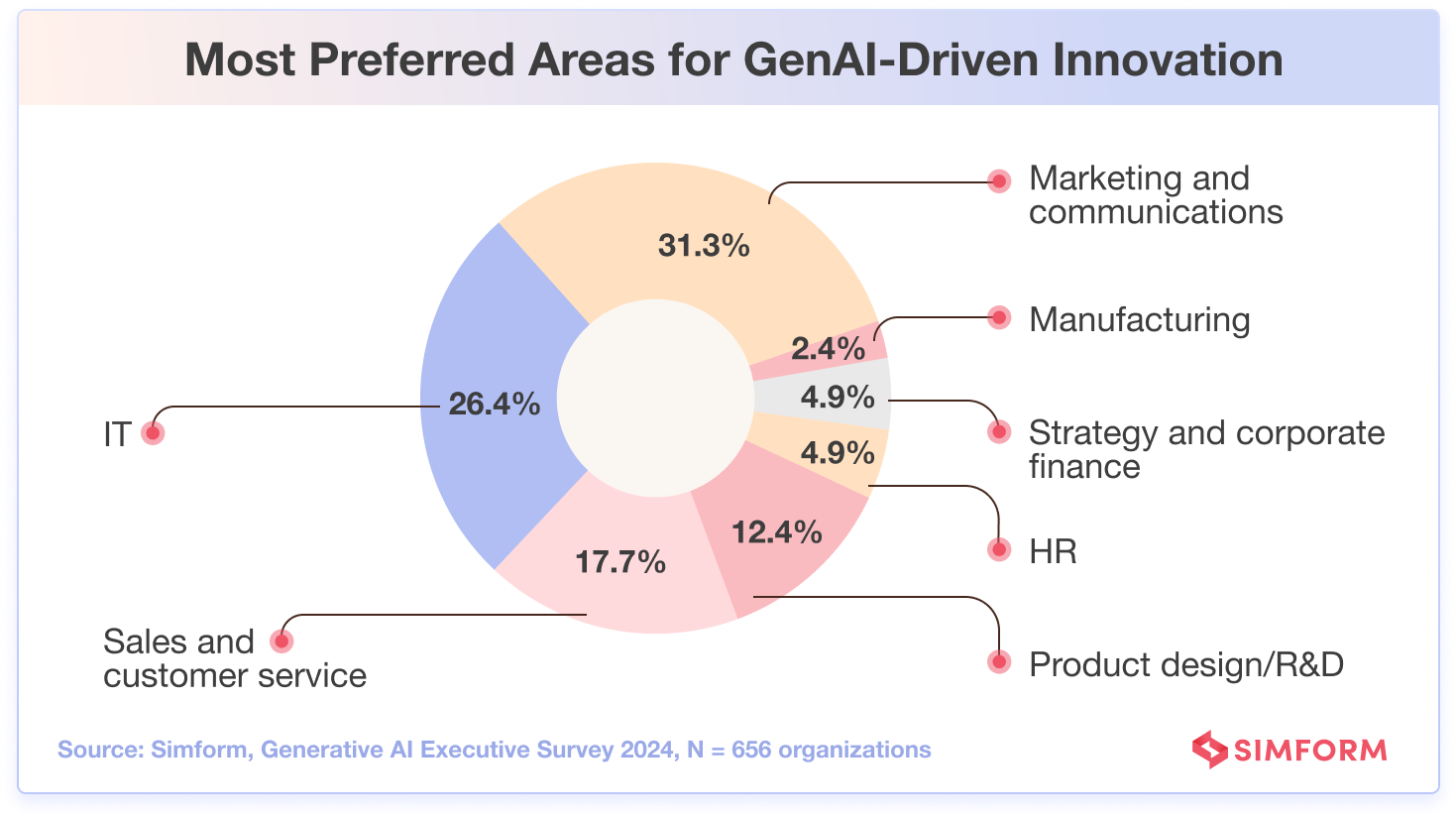
State of Generative AI in 2024 | Insightful Survey Findings
G. Business strategy and decision making
19. AI-powered decision support systems (DSS)
AI-powered DSS, also referred to as Intelligent Decision Support Systems (IDSS), quickly turn mountains of unstructured text into specific and usable document summaries, paving the way for more informed decision-making.
Relevant data from multiple sources, such as databases, spreadsheets, and external data feeds, is integrated into the DSS along with predefined rules, constraints, and objectives that guide decision-making processes. These systems have a user-friendly interface to input data, view recommendations, and explore scenarios or “what-if” analyses.
DSSs integrate various AI techniques to assist in complex decision-making processes. This may include predictive analytics models to forecast outcomes, optimization algorithms to identify optimal solutions to constraints, and NLP.
Uber’s marketplace algorithms act as a real-time DSS, optimizing rider-driver matches, pricing, and routing. The system analyzes factors such as traffic conditions, rider demand, and driver availability to make split-second decisions that maximize efficiency and user satisfaction.
20. Competitive intelligence and market analysis
AI can be leveraged to gather and analyze data from various sources, including news articles, social media, market reports, and competitor websites, to gain insights into industry trends, competitor strategies, and customer sentiments.
Web scraping, APIs, and other data collection methods gather relevant data from online sources. NLP techniques extract valuable information from these unstructured data sources, such as social media posts. AI models can then identify sentiments, opinions, and trends related to specific products, brands, or companies.
Global cosmetics manufacturer L’Oréal has developed a system called TrendSpotter that uses AI to analyze millions of comments, images, and videos posted online. The aim is to spot trends before rivals do so that L’Oréal can develop on-trend products and incorporate the terms and topics that engage consumers into its online marketing.
We built a tweets-driven market intelligence solution for pharma industry
21. Risk assessment and mitigation
AI can assess various types of risks, such as credit, operational, and market risks, by analyzing large datasets and identifying potential risk factors, enabling better risk management and decision-making.
AI/ML models can assess the likelihood and potential impact of identified risks, providing risk scores or rankings to prioritize mitigation efforts. Further, optimization algorithms and DSS can be employed to recommend optimal risk mitigation strategies based on risk assessments and organizational constraints.
AI models can also continuously monitor data streams and provide real-time alerts or updates on emerging risks, enabling proactive risk management.
Overall, AI improves the speed of business by enabling shorter business cycles. By automating internal and customer-facing processes, it reduces the time to move from one stage to the next, such as from designing a product to commercialization, resulting in faster ROI.
These use cases showcase the versatility of AI in addressing diverse challenges across various enterprise functions. However, successfully implementing enterprise AI applications is not without its hurdles. Recognizing these challenges is crucial to derive the most value from this rapidly evolving technology.
Challenges of implementing AI in enterprise
1. Data quality and availability
AI algorithms require large amounts of high-quality, relevant data to function effectively, lack of which is one of the most significant challenges in implementing AI. For many organizations, their existing data may be:
- Fragmented, inconsistent, or simply insufficient for training robust AI models
- Siloed across different departments or systems
- Contain biases or inaccuracies that can lead to skewed AI outputs
Overcoming this challenge requires a comprehensive data strategy, including establishing data cleaning and preprocessing pipelines, robust data governance practices, and potentially exploring data augmentation techniques.
2. Integration with legacy systems
For many established enterprises, legacy IT infrastructure may not be compatible with modern AI tools and platforms. These systems often operate in silos or may lack the necessary computational and data storage capabilities necessary to implement AI solutions.
Gradually modernizing IT infrastructure or in some cases, undertaking significant digital transformation initiatives may be needed to create an environment conducive to AI implementation.
3. Scalability issues
AI solutions that work well in pilot projects or controlled environments could face challenges when scaled across the entire enterprise. For instance, computational resources required for large-scale AI deployment may exceed initial estimates or data pipelines may break down under the volume and velocity of data in full-scale deployment.
Careful planning from the outset and designing AI systems with scalability in mind can avoid these problems. Robust MLOps (Machine Learning Operations) practices can also help manage the lifecycle of AI models at scale, including version control, automated testing, and monitoring of model performance.
4. Regulatory compliance
As AI becomes more prevalent in business operations, it increasingly falls under the purview of various regulations. These can include industry-specific regulations (such as in healthcare or finance) as well as broader data protection and privacy laws.
Thus, building compliance checks into AI systems from the ground up is crucial, as is maintaining detailed documentation of AI decision-making processes for audit purposes. In some cases, organizations may need to limit the use of AI in certain sensitive areas or develop hybrid human-AI systems to ensure regulatory compliance.
5. Lack of AI expertise
Another major hurdle for implementing generative AI in the enterprise is the shortage of skilled professionals. They may lack the in-house capability to develop, implement, and maintain sophisticated enterprise AI software.
Addressing this requires a multi-faceted approach, including investing in upskilling programs for existing employees, partnering with AI development service providers, and fostering a culture of continuous learning to keep pace with AI advancements.
A “technology for technology’s sake” approach often leads to projects that, while technically impressive, fail to deliver meaningful business value. Adopt a “product mindset” in AI implementation to clearly define business problems before selecting AI solutions and prioritize practical, value-driven results over technological sophistication for a successful AI implementation.
Deploy enterprise-scale AI solutions with Simform
AI is no longer just a tool for efficiency; it’s becoming a core driver of business strategy and innovation. However, moving from proof of concepts (PoCs) to deploying enterprise AI products at scale requires the right expertise, resources, and a strategic approach.
Simform has extensive experience in developing enterprise solutions and a deep understanding of AI technologies, data engineering, and cloud computing. It makes us uniquely positioned to help enterprises navigate the complexities of AI implementation. Whether it’s developing custom AI models, integrating AI with existing systems, or ensuring the scalability and robustness of AI applications, Simform offers end-to-end AI development services tailored for your specific needs.
Our special unit, AI studio, has its own engineering culture and practices aimed at experimentation and innovation. AI Studio has built proprietary libraries and MLOps tools that help us deliver better AI/ML solutions faster. To learn more about how we can help you deploy AI solutions that deliver measurable impact, contact us today!
